
This week’s breakdown looks into an early 1930 Terrytoon!
As with the other early Terrytoons previously analyzed here, head animator Frank Moser is given a large amount of footage in this cartoon. Moser’s credited scenes also list his assistants, which include Art Babbitt, Tom Byrne, Tom Bonfiglio, and “Sarka.” No further evidence has surfaced if “Sarka” is fine artist Charles Sarka, so the video only bears the credited last name, as listed on the draft.
The early Terrytoons were adept in sound synchronization. Like many early sound cartoons, they consist of small vignettes loosely based on general setting while managing to obey the novelty of each film’s theme. Set in Holland, this cartoon naturally has sequences of tulips and windmills in wooden clogs, dancing rhythmically to the music. Besides this innovation, an interesting facet of the early East Coast cartoons is the spontaneity of their gags. It’s bewildering to watch such scenes as a mother spanking her kids right to bed with no painful repercussions, or a little dog throwing a cow off into the distance when viewers are more accustomed to the grounded organization of the West Coast cartoons. The strange nature of these sequences reflects how the animators served as their own gagmen, in the same fashion New York cartoonists worked in the silent era. Early sound cartoons often added fundamental plotting to articulate what little narrative they had, such as scenes with the puppy and the little girl seen in this entry. The climactic rescue over a waterfall, with a turkey dinner reward, recalls earlier Terry-produced cartoons, particularly Three Orphans of the Storm, a 1923 Aesop’s Fable.
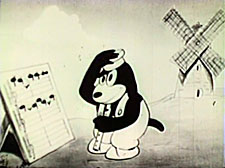 Dutch Treat offers several surprises from an animation standpoint. Scenes 33 and 34, with the mother and little puppy singing (animated by Moser) are interesting glimpses of exercising lip-sync properly. The slow exposures add a nice touch as well. Jerry Shields’ scene 5 has an interesting layout— the trees in the background move in perspective. Moser’s sequence of the little dog playing the piccolo, shrinking in volume as he performs, is amusing in an odd way. Art Babbitt’s scene 12 might be one of his earliest sole sequences, with a nice piece of acting. The little black puppy blows a raspberry at his father, and. after a look of self-assurance to the camera, receives a clog thrown at his head. Terry’s own animation here is remarkably crude—even more so than Shields, with drawing similar to his silent Fables.
Dutch Treat offers several surprises from an animation standpoint. Scenes 33 and 34, with the mother and little puppy singing (animated by Moser) are interesting glimpses of exercising lip-sync properly. The slow exposures add a nice touch as well. Jerry Shields’ scene 5 has an interesting layout— the trees in the background move in perspective. Moser’s sequence of the little dog playing the piccolo, shrinking in volume as he performs, is amusing in an odd way. Art Babbitt’s scene 12 might be one of his earliest sole sequences, with a nice piece of acting. The little black puppy blows a raspberry at his father, and. after a look of self-assurance to the camera, receives a clog thrown at his head. Terry’s own animation here is remarkably crude—even more so than Shields, with drawing similar to his silent Fables.
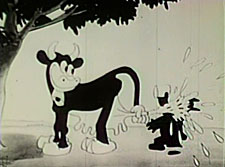 Tom Bonfiglio (who later changed his last name to Goodson) served as an assistant on the first season or two of Terrytoons, then animated for the Betty Boop series at Fleischer. He migrated to Disney’s as a junior animator under Ben Sharpsteen, in such cartoons as Father Noah’s Ark and Mickey’s Mechanical Man. Goodson then went over to Van Beuren. There, he worked with Ted Esbaugh on The Sunshine Makers, now regarded as a cult classic. Goodson held the highest respect for Disney and little respect for others (especially New York studios) in his later years, According to a Terrytoons roster of employees — circa 1936-37 — Bonfliglio went back to Terry after Van Beuren closed. His career took a standstill when he enlisted in the military before returning to animation on local commercials for Perceptual Development Laboratories in St. Louis.
Tom Bonfiglio (who later changed his last name to Goodson) served as an assistant on the first season or two of Terrytoons, then animated for the Betty Boop series at Fleischer. He migrated to Disney’s as a junior animator under Ben Sharpsteen, in such cartoons as Father Noah’s Ark and Mickey’s Mechanical Man. Goodson then went over to Van Beuren. There, he worked with Ted Esbaugh on The Sunshine Makers, now regarded as a cult classic. Goodson held the highest respect for Disney and little respect for others (especially New York studios) in his later years, According to a Terrytoons roster of employees — circa 1936-37 — Bonfliglio went back to Terry after Van Beuren closed. His career took a standstill when he enlisted in the military before returning to animation on local commercials for Perceptual Development Laboratories in St. Louis.
 Animator Mark Kausler remembered Goodson as a benevolent man who taught the young junior high student the basics of in-betweening. He wasn’t without his vices, as Kausler recalled: “He would occasionally walk over to his trench coat, which was hanging on a clothes tree by the wall, and sneak a drink from a pocket flask he had in it.” Whatever disdain he held for the New York studios, Mark remembered that Goodson’s large tempera paintings, with classical dwarfs and elves “surrounded by big chemical jars with colorful liquids inside them” in vibrant cavern settings, showed a particular Fleischer influence.
Animator Mark Kausler remembered Goodson as a benevolent man who taught the young junior high student the basics of in-betweening. He wasn’t without his vices, as Kausler recalled: “He would occasionally walk over to his trench coat, which was hanging on a clothes tree by the wall, and sneak a drink from a pocket flask he had in it.” Whatever disdain he held for the New York studios, Mark remembered that Goodson’s large tempera paintings, with classical dwarfs and elves “surrounded by big chemical jars with colorful liquids inside them” in vibrant cavern settings, showed a particular Fleischer influence.
There is curious film technique in Dutch Treat’s editing. When looking at the cartoon and the draft, notice when the background cuts away while the characters continue to move. This occurs twice in the cartoon, and counts as two separate shot listings—scenes 27 and 27A, where the black puppy rides the duck up to the sky during the rescue, and scenes 34 and 35 where he receives the turkey and runs off to the left.
This copy of Dutch Treat seen here is a TV print which cuts off the end gag of the little black dog spitting into the father’s hand before exiting into the horizon. Some of the only available copies of early Terrytoons are the CBS television versions, in which the network censored any offensive material. A character spitefully expectorating on another person’s palm might have been one of their “hot buttons.”I’ve read a recent post from Thad’s blog about an upcoming book on New York animation (from the teens to the ‘60s), co-authored by Terry expert Charlie Judkins. With Tom’s upcoming Bray Studios set and the Cartoon Carnival documentary on the way, that Maltese Falcon statue might be obsolete…this is the stuff dreams are made of (for us hard-core animation buffs, anyway…)
Sit back and enjoy this Dutch Treat!

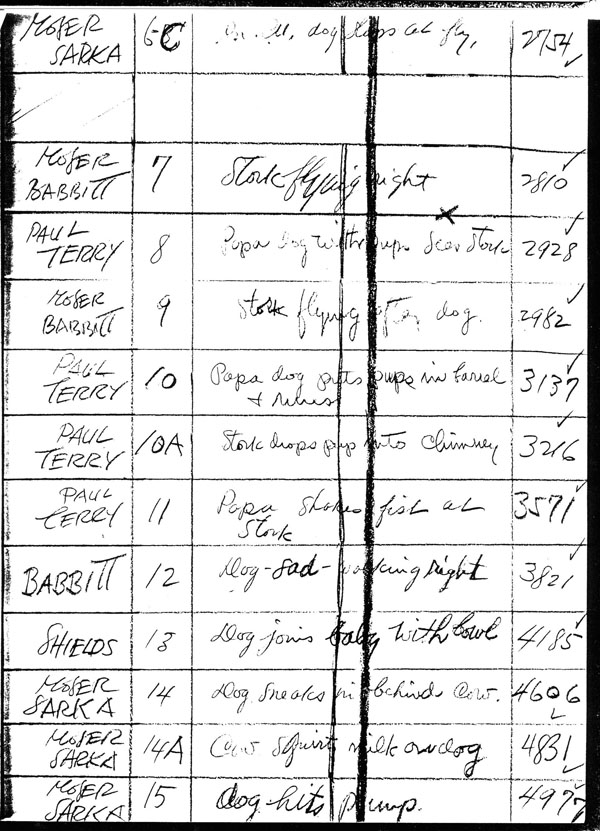
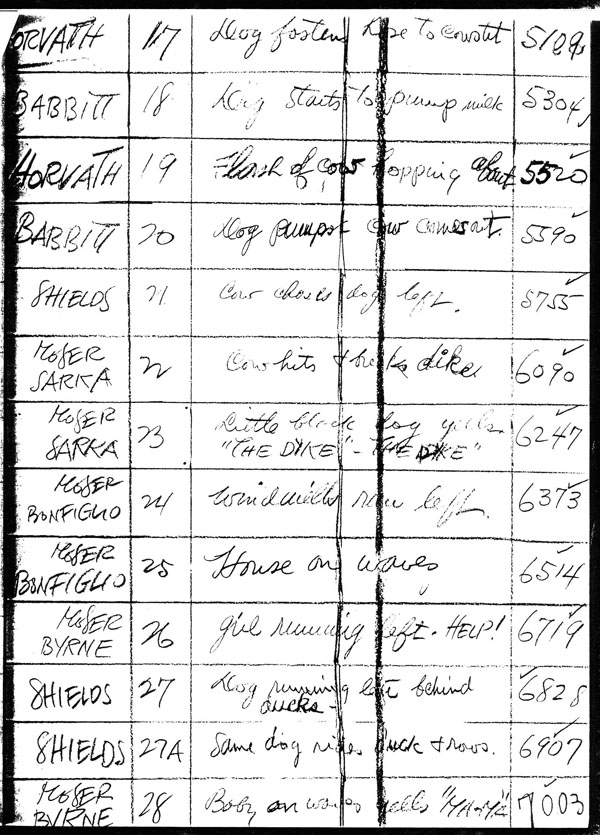
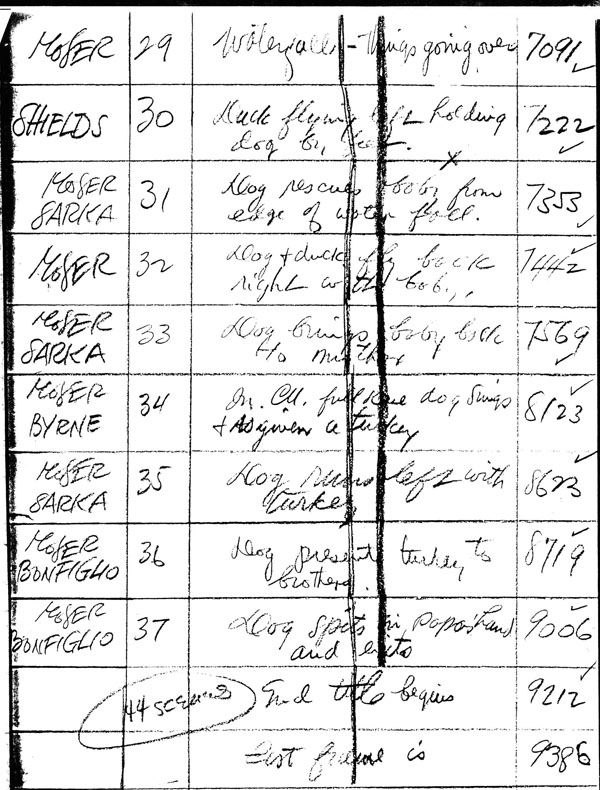
(Thanks to Mark Kausler and Charlie Judkins for their assistance.)


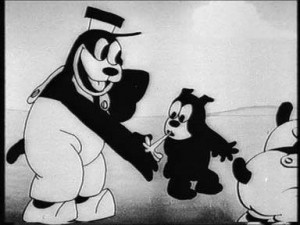
 DEVON BAXTER is a film restoration artist, video editor, and animation researcher/writer currently residing in Pennsylvania. He also hosts a
DEVON BAXTER is a film restoration artist, video editor, and animation researcher/writer currently residing in Pennsylvania. He also hosts a 





















































































Devon:
In spite of there only being TV prints as a source,you did your usual good job of breking them down! I’ve got to get that forthcoming book on New York animation,as well as seeing that Cartoon Carnival docuementary!Thanks for sharing!
I remember reading in someone’s book, maybe Leonard Maltin’s, that Terrytoons did all their soundtracks in one take – music, voices, sound effects – and any mistakes had to be incorporated into the animation. I don’t know how true that was, but I can believe they did it on this one. You see a Dutch mama weeping, but no “boo hoo”. Must have been frustrating to the animators, being locked in to such rigid timing with no discretion allowed.
Is it my imagination or does this cartoon almost feel like a remake of an early silent Aesop fable?
Peter, many cartoons were still recorded in this fashion until circa 1936, when dialogue pre-recording and hiring outside radio /acting talent began becoming more and more common. I think Harman-Ising on the coast and Disney were the first to pre-record. It was a later phenom in NY studios, although after animation it was still common to have session to lay in effects, vocal effects and music while picture was running. Also, a cartoon like this, released in fall of 1930, will sound pretty primitive to us today because that was still very early in the piece and the art of audio synching was being honed and perfected…I regard the period 1928-38 (from STEAMBOAT WILLIE to the premiere of SNOW WHITE) as a decade of vast experimentation and achievement in the cartoon field.
That ‘one less cell of background’ technique is brilliant – we immediately know some time has passed. I don’t know how how well the audiences of the time would have interpreted it.
I CAN’T WAIT FOR MORE BREAKDOWN ANIMATIONS IN THE FUTURE!!
CAN YOU DO MORE TERRYTOONS BREAKDOWN ANIMATIONS?
https://www.youtube.com/watch?v=GN2Ecccl5Fg
Here is the uncensored version of the cartoon, courtesy of hammerson.